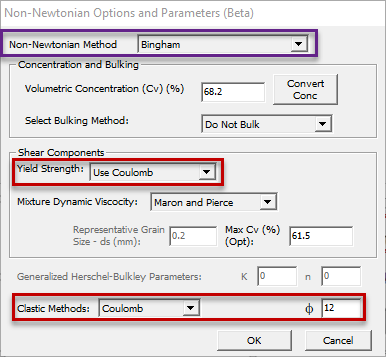Download PDF
Download page Yield Stress.
Yield Stress
All of the linear and non-linear rheological models require a yield stress. Mathematically, the yield stress is the y-axis intercept of the stress-strain relationship. Conceptually, it is the range of stresses over which the mixture does not move.
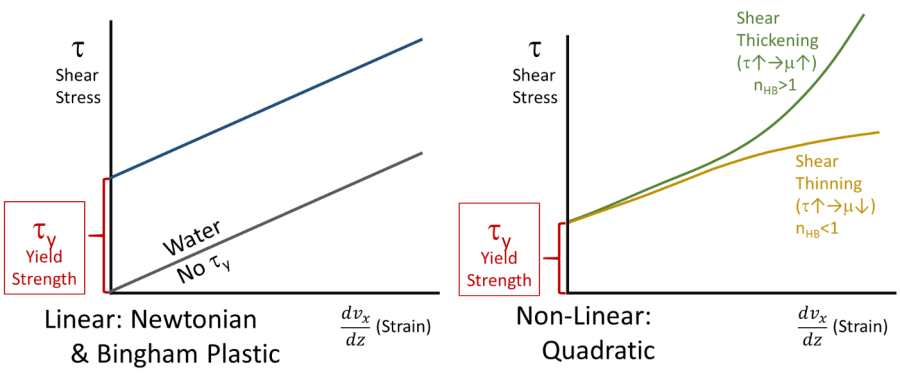 This is one of the important differences between Newtonian and Non-Newtonian fluids. Newtonian fluids have a zero stress-strain intercept, which just means that they deform (move) at under the slightest stress. Water has no internal strength, so very small stresses move it. It is only at rest under no-stress conditions.
This is one of the important differences between Newtonian and Non-Newtonian fluids. Newtonian fluids have a zero stress-strain intercept, which just means that they deform (move) at under the slightest stress. Water has no internal strength, so very small stresses move it. It is only at rest under no-stress conditions.
Non-Newtonian mixtures often have internal strength, however. They resist motion under a range of stresses. The driving forces have to exceed this internal strength before the material moves (deforms or strains). The rheological models account for this with a Yield Strength. This y-intercept in the stress-strain relationship is a motion threshold. As long as τ<τy the fluid is at rest.
This yield strength drives one of the most important processes in mud and debris flows that Newtonian models cannot simulate: run out. Water will flow downslope indefinitely. Even if flow attenuates and slope decreases, as long as the flow has some slope or momentum it will stay in motion. Mud and debris flows can come to rest, even on a relatively steep slope. As driving forces decrease, the strength of the particle interactions can exceed the stress of the slope and momentum of the fluid, causing it to stop or "run out." The Yield Strength drives this process.
Yield stress is difficult to measure. Laboratory measurements like tilt tests can estimate yield strength when solid particles are small enough to sample and if the fluid can be sampled or reconstituted. But sampling mud and debris flows is difficult and modelers have to make some assumptions in predictive models. Therefore, HEC-RAS includes three approaches to Yield Strength.
Exponential
Because direct measurements of yield strength are rare, the Exponential empirical method is the default approach. Several researchers have found that yield strength is an exponential function of the volumetric concentration. Therefore, the Exponential method incorporates two empirical parameters into an exponential function of the volumetric concentration:
| \tau_y = ae^{bC_v} |
where a and b are calibration coefficients, and Cv volumetric concentration between 0 and 1.
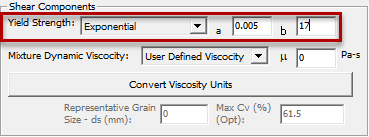
Figure 3-20: The exponential equation for yield strength embed two empirical coefficients in an exponential function of volumetric concentration.
O'Brien and Julien (1988) published values for these empirical parameters. These coefficients vary widely, so they are often calibration parameters. But these values can serve as a starting point for a calibration.
Table 3-2: Yield stress parameters for the O'Brian equation from Julien (1995) (converted to the exponential form used in HEC-RAS)
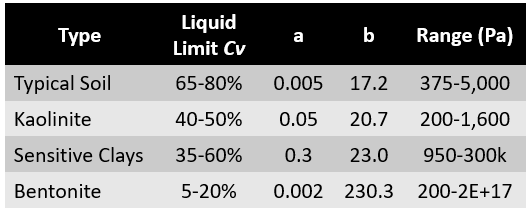
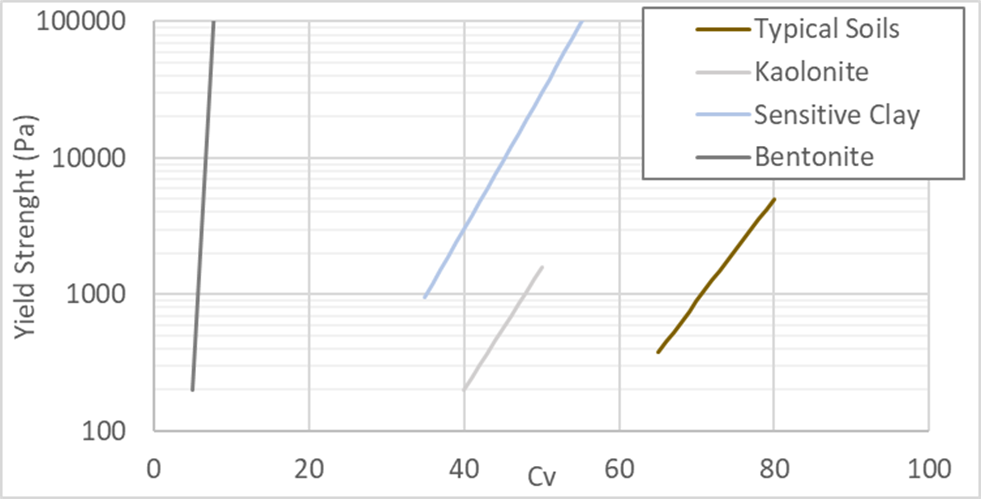
Note: HEC-RAS parameters are not necessarily the same as similarly named parameters in FLO2D. For a useful description of how to convert parameters between FLO2D and HEC-RAS see Dimas, et al (2023) "Comparison of mudflow simulation models in an ephemeral mountainous stream in Western Greece using HEC-RAS and FLO-2D", Euro-Mediterranean Journal for Environmental Integration.
User Yield
The user specified Yield Strength is the most direct way to input the yield strength. Just select User Yield and define the Yield Strength (in Pa – the initial release of the Non-Newtonian editor uses SI units but is compatible with SI and US customary simulations). 
Use Coulomb
In the rheological models the yeild stress is – conceptually - an internal property of the single-phase fluid mixture. However, there is another way to think about Yield and runout. As the concentration increases (or as the mixture dewaters) the particle interactions transition from collision to inter-particle friction. In this transition from collision to friction, the dominant processes transition from fluid mechanics to geotechnical processes. The third approach to yield strength takes this approach. Selecting Coulomb under Yield Strength activates the Coulomb model under Clastic Methods even if a Rheological model (i.e. Bingham, O'Brien, HB) is selected for the Non-Newtonian Method. In this mode, HEC-RAS will use geotechnical Coulomb theory to compute a Yield Strength (τy) in the rheological model. With this approach, the Yield Strength will be the stress required to initiate motion along the friction plane.
This approach differs from selecting Clastic Methods and Coulomb because applying the Coulomb approach as a clastic method only considers the geotechnical threshold stress. Selecting Coulomb as a Yield Strength method in conjunction with the Rheological Non-Newtonian methods (i.e. Bingham, O'Brien, HB) uses the Coulomb method to compute the threshold of motion by using it for yield stress (τy in each equation at the top of this page) but then adds the viscous and/or non-linear components.
The Coulomb method requires a friction angel to compute the threshold of motion.